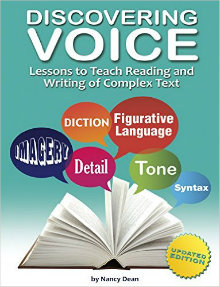Help Students Discover Voice in Complex Text
Discovering Voice: Lessons to Teach Reading and Writing of Complex Text
By Nancy Dean
(Maupin House/Capstone Classroom, 2015/6 – Learn more)
 Reviewed by Sarah Shah
Reviewed by Sarah Shah
Ahh, the elusive concept of ‘Voice’ in writing. What is it? How does one teach it? In Discovering Voice: Lessons to Teach Reading and Writing of Complex Text, Nancy Dean proposes a series of structured mini-lessons to help students come to a deeper understanding of this often misunderstood concept.
After reading through the lessons in detail, I believe that incorporating them will indeed help my students grasp the idea and application of voice in what they read, and, perhaps more importantly, in what they write.
 This book is simple, straightforward, and without frills. If you are looking for a glossy, colorful, jazzy (insert spirit fingers here!) book with high production value, you’ll have to look elsewhere. I have to admit that initially I had to force myself to start reading this because it looked so, well, bare-bones!
This book is simple, straightforward, and without frills. If you are looking for a glossy, colorful, jazzy (insert spirit fingers here!) book with high production value, you’ll have to look elsewhere. I have to admit that initially I had to force myself to start reading this because it looked so, well, bare-bones!
But my initial reaction gave way to engagement as I read on. Though Dean may have forgone the bells and whistles, she has delivered a solid, implementable set of high-quality lessons using familiar excerpts from complex and engaging literature.
For example, the lesson on diction
Let me give you an example of one of the lessons so you can get a sense of Dean’s approach. After introducing the concept of ‘diction’ by focusing on words that have become boring and lost their ‘freshness,’ as well as explaining ways writers utilize connotation to convey their meaning to readers, Dean shares with students an excerpt from Frances Hodgson Burnett’s The Secret Garden ( a personal favorite of mine; I think I’m eternally searching for that garden!).
Certain words in the selection are bold-faced, such as ‘gaunt’ and ‘famished.’ Dean then prompts students to ‘Talk About It,’ asking students how the bolded words intensify the understanding of just how ferocious the wolves (in the passage) are.
Lastly, she requests that students apply their understanding in the “Now you try it’ portion of the lesson. Students must write down strong adjectives that intensify the reader’s understanding of dogs in a made-up sentence that follows the same structure as the one from The Secret Garden. Using the excerpt as a guide, they are asked to come up with two.
A set pattern with helpful variations
Most of the lessons follow this same structure, which reminded me of the “I Do, We Do, You Do” teaching method of gradual release of responsibility, empowering students to independently understand/apply the concept by the end of the lesson. It’s similar to using training wheels when teaching a child to ride a bicycle. If a teacher wanted to, he or she could do the “Read and Think” as a whole-class introduction, perhaps do a ‘thinkaloud’ for the first “Talk About It,” and then have students work together for the second. Then, after reviewing the partner or group discussions, the students could be asked to do the “Now You Try It” independently.
Of course, this is just one way to use the structured lesson; there are many possibilities, and it would be easy to tailor the lessons to your students’ ever-changing needs.
Towards the end of the book, Dean gives additional suggestions for teaching voice, and many of them are great! Though I’ve used a few of them before, many were new to me and seemed both creative and easy to implement. For example, the “Syntax in the Headlines” activity caught my eye as one that would benefit my students and that they would enjoy working through as well.
Finally, Dean concludes with some ‘Discussion Suggestions’ to help guide the ‘Talk About It’ sections of the lessons. She clearly states that these are suggested answers, “and by no means exhaust the possible responses to the questions.”
Straightforward help instead of flash
I absolutely plan to try out these lessons with my students this school year. Though there is nothing earth shattering or world changing in this book, it delivers on its promise. I really like the structured, straightforward approach and the recognizable and interesting excerpts she’s chosen for students to analyze.
As with anything, making the lesson truly meaningful will require each individual teacher to adapt, infuse, and deliver the lesson with his/her own style and knowledge of his/her students. Sometimes flash and gloss in teacher books hides meager content, but with Discovering Voice: Lessons to Teach Reading and Writing of Complex Text the opposite is true!
Sarah Shah is a 6th grade English teacher at Robert Frost Middle School, a Blue-Ribbon middle school in Montgomery County, Maryland. She’s entering her 10th year of teaching and has experience across a variety of school environments ranging from urban to suburban. Sarah was recently selected for the Newseum’s Summer Institute (Primarily Digital: Teaching Media Literacy to Plugged in Students).
Sarah has also co-presented a session entitled “Joining Forces: Empowering Responsible 21st Century Learners” at the Maryland Association of School Librarians Conference. She worked briefly at The Education Trust, an ed policy think tank, and published a piece called “Welcome to Middle School: The Role of Parents During the Transition” for their blog. Follow her on twitter @sarahemilyshah.


































An insightful review!!!